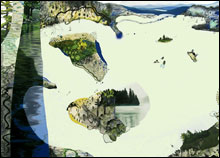 The conundrum, as Sandy Litchfield boiled it down for me recently, was that we’ve all seen stunning sunsets in nature, but what painting has evoked that same sensation? How could she render landscapes in a way that captures the spark and the surprise she experiences while tromping through the patchwork of nature preserves near her home in Amherst, or the hills around her family’s summer home in the Adirondacks?
The conundrum, as Sandy Litchfield boiled it down for me recently, was that we’ve all seen stunning sunsets in nature, but what painting has evoked that same sensation? How could she render landscapes in a way that captures the spark and the surprise she experiences while tromping through the patchwork of nature preserves near her home in Amherst, or the hills around her family’s summer home in the Adirondacks?
In a mostly unconscious way, the 39-year-old is wrestling with the ghosts of Thomas Cole and the 19th-century Hudson River School, who hunted some of the very territories she travels for subjects to paint and who still loom large in American art with their landscapes celebrating the nation’s natural wealth and its westward expansion while also, already, beginning to lament the taming of its wilds.
“Surrounding Practice” at Bernard Toale Gallery elaborates on the answer that Litchfield came to while earning her MFA degree at UMass-Amherst in 2003 and that was represented in her works in the DeCordova Museum Annual Exhibition the following year. At first she tried painting conventional landscapes, but they weren’t quite right. Now she frequently ventures outdoors, but she doesn’t sketch on site. Instead, she snaps digital photographs and collects leaves, rocks, and twigs to kindle inspiration at home. Over the nest 24 hours, she jots down her impressions. She often develops these into small watercolors, like the 16 hung in the Toale main gallery, in which the landscape is abstracted into flowing shapes that find their own boundaries, unmindful of the edge of the page. They feel like an explorer’s notations. And these, in turn, beget Litchfield’s full-scale paintings in oil, acrylic, and ink.
Inspired by the summer home on Blue Mountain Lake, which she’s visited all her life, the six-by-eight-foot canvas Summer Reunion (2006) shows a pale-green lake speckled with islands and ringed by a wooded coast. An island in the northwest is built atop a thin gray-brown wash that defines the land mass; wavy lines along the island’s bottom edge delineate the shore; forested areas are jotted in as round dashes. One swath is built up into an impasto of green and yellow dabs, circles, and wiggly lines, the thickness of the paint suggesting more dense topography as well as greater psychological importance.
The 2004 work from which the exhibit borrows its title is a 20-foot-long painting affixed directly to the gallery wall starting in the lobby and continuing around a corner into the main gallery. Your eye follows the black and gray path winding through woods, a boulder field, clover, pebbles, marshy spots. Litchfield switches smoothly between runny, watery paint and impasto, between quick diagrammatic passages rendered like symbols on a map and blurry representational images of evergreens reflected in the lake.